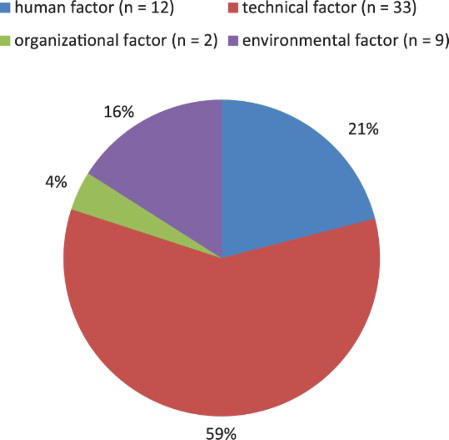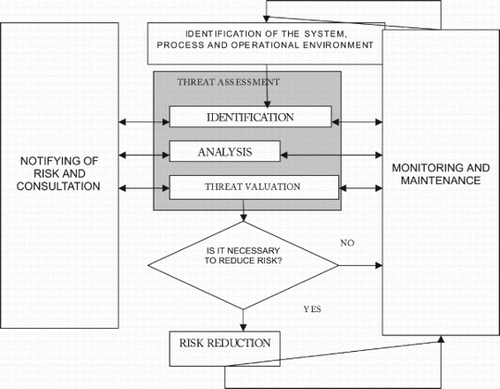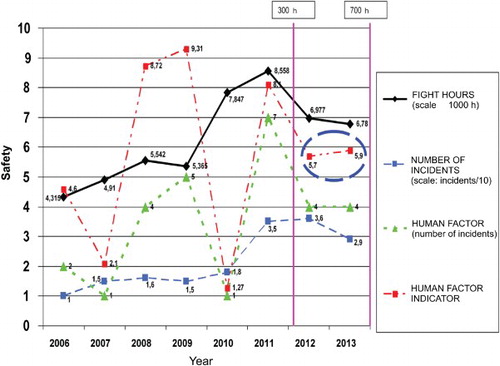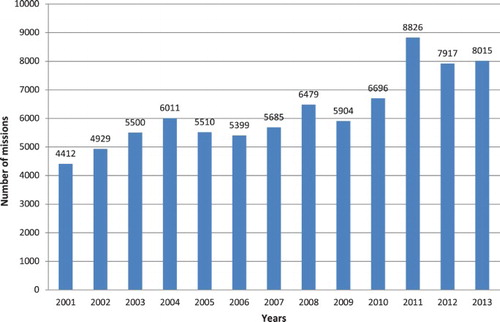Abstract
In 2008, the Polish Medical Air Rescue started replacing its fleet with modern EC135 machines. To ensure the maximum possible safety of the missions performed both in the period of implementing the change and later on, the management prepared a strategy of training its crews to use the new type of helicopter. The analysis of incidents that occurred during 2006–2009 showed that both the human and the technical factors must be carefully considered. Moreover, a risk analysis was conducted to reduce the risk both during general crew training and in the course of particular flight operations. A four-stage strategy of training pilots and crew members was worked out by weighing up all the risks. The analysis of data from 2010 to 2013 confirmed that the risk connected with flying and with all the activities involved in direct support aircraft operations is under control and lowered to an acceptable level.
1. Introduction
The main aim of the government program for replacing the fleet of Emergency Medical Service (EMS) helicopters in Poland was to fulfill the duties resulting from European flight regulations which specify the technical requirements for the aircraft used by EMS operators in European Union countries, which were no longer met by Mi-2 plus helicopters. The second aim was to increase the operation capabilities of the Helicopter Emergency Medical Service (HEMS) in the area of performing aviation tasks using the new type of helicopter. The technical and operational requirements described in European flight regulations comprise a system that must be met by both the helicopter and the crew to minimize the risk resulting from performing rescue flights in an environment which is unknown and, therefore, unsafe (e.g., flights to accidents which are different each time, operations in the mountains, or at night). After using Mi-2 plus helicopters for almost 30 years, the process of replacing the Polish Medical Air Rescue (PMAR) fleet with more modern EC135 machines started in 2008. To ensure the maximum level of safety during the missions performed both in the transition period and in the course of later operations, the management of the company started preparing a strategy of training HEMS crews for the new type of helicopter. Such a strategy involves not only the technical aspects of the pilot's work, the manual for which is obtained when purchasing a new helicopter and implementing its use, but also a number of other significant undertakings which must be performed to reach a satisfactory level of preparing crews for independent operations connected with rescuing human life and health. Although many flight operators in the world use helicopters of this kind, none has hitherto predicted as radical a difference in the level of technology as the one which took place in Poland. This is why transferring foreign training patterns to Polish conditions would not meet the requirements posed by the rapid preparation of Polish pilots and air crews for operating the new type of helicopter. Moreover, under Polish conditions, EMS services were of a specific character because only one type of helicopter had been used for years, which was radically different in its technology from the newly purchased machines. Such a situation called for preparing a specifically Polish type of training course, and implementing specific organizational and operational solutions before introducing the new helicopters.
The basic challenge that had to be met while developing the training strategy was – paradoxically – the extremely rich experience of HEMS crews, which comprised hundreds and even thousands of work hours. This is because the technology used in the Mi-2 plus technologies came from the 1970s, while EC135 is a modern, complicated machine with the latest technical solutions that are now used in aviation. The EC135 has been designed for the needs of medical rescue services. It is equipped with the necessary medical devices for saving human life and health and a new system of loading the patient on board. Modern solutions in the main rotor and its decreased diameter make it possible for the machine to land in more difficult terrain, both during the day and at night. Modern aviation means using multi-function display screens in the cockpit; a device warning of the approach of other aircraft; an autopilot co-functioning with other devices; a weather radar; full authority digital engine control; a flight management system integrated with a moving map display, global positioning system, and emergency locator transmitter; an enhanced vision system making night vision possible by means of a camera installed under the helicopter; and instrument flight rules.
In this situation, experienced HEMS pilots and crew members were forced to abandon the fixed work patterns acquired over many years and learn new procedures. The transfer from analog pilot and navigational systems available in the Mi-2 plus helicopter to the very advanced electronic systems of the new chopper was connected with a risk that had to be minimized.[Citation1]
2. Developing training strategy: assumptions
The main factors determining the safety of an aircraft carrier are worked out by considering the number of accidents and their causes. Before making assumptions for the purchase of new PMAR helicopters, the accidents involving Mi-2 helicopters over the past 4 years of using them, i.e., during 2006–2009, were analyzed. Drawing the correct conclusions from such a study is possible if the analysis diagnoses the system of human factor–machine–surroundings. In such an analysis, the human is referred to as the decision-maker and operator. There is no place here for the task to be met. What is studied is the following sequence: the human activates the machine, which in turn impacts the surroundings to obtain the desired objective (a change of location, etc.).[Citation2,Citation3]
The results of the analysis are presented in – and in . The groups of causes leading to flight incidents are specified in accordance with the Annex to Order No. 14 issued by the President of the Civil Aviation Authority.[Citation4]
Table 1. Groups of causes leading to aviation incidents in the human factor (H) category and the number of incidents during 2006–2009.
Table 2. Groups of causes leading to aviation incidents in the technical factor (T) category and the number of incidents during 2006–2009.
Table 3. Groups of causes leading to aviation incidents in the organizational (O) factor category and the number of incidents during 2006–2009.
Table 4. Groups of causes leading to aviation incidents in the environmental (E) factor category and the number of incidents during 2006–2009.
An analysis of data presented in Tables – and in showed that human-related and technological factors constituted the basic causes of flight incidents and should, therefore, be particularly emphasized in the training strategy. As far as the human-related factor is concerned, procedural errors turned out to be especially frequent. Errors of this kind are connected with non-observation of flight procedures and regulations. They were identified as a particularly significant factor generating dangerous situations in PMAR operations, which concern not only flying personnel but are committed in such areas as technology, the environment, and organization. Regulations specify such concepts as ‘unintentionally departing from observing procedures or regulations.'[Citation4] Most human-related errors are unintended and result from a series of coincidences that are conducive to committing a mistake.
Most unintended incidents, particularly aviation accidents, stem from a combination of a series of contributing events and circumstances called an error chain.[Citation5] The training strategy adopted was therefore based on a systemic approach to the problem, in particular a holistic view of flight safety,[Citation6] as illustrated in .
An analysis of the factors included in the safety chain () made it possible to develop detailed areas of indispensable training arising from the specifics of the new type of helicopter, such as pilot training, avionics, technical and operational parameters, and ground maintenance.
In the course of developing the training strategy for the new helicopter, it was assumed that the main objectives of the courses determining the kind of appropriate training model and appropriate syllabus were as follows:
planning and carrying out courses which would train HEMS crews to fly the new helicopter taking into consideration the need to make the necessary technological jump (leapfrogging);
eliminating unfavorable habits acquired in the course of flying the old generation of helicopters;
mastering the new technological solutions used in EC135 helicopters in a way ensuring their safe operation; and
enhancing the safety of HEMS crews when carrying out their missions by means of team work and training courses conducted jointly with other EMS units.
Figure 3. Algorithm of the training process in the Polish Medical Air Rescue (PMAR).
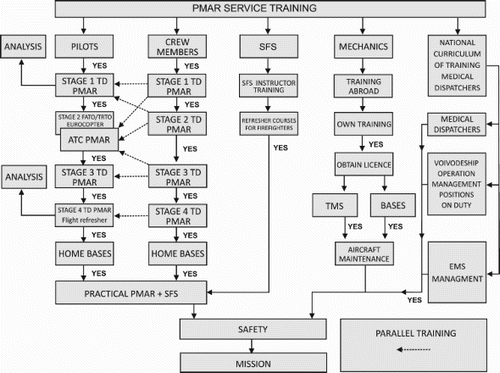
Section 1 of this article defined the risk connected with the extensive experience of the crews and their habits developed while using analog systems, which gave rise to difficulties in transferring to advanced electronic systems in EC135 aircraft. It was assumed that the pilot operating the aircraft and the paramedic who is an HEMS crew member would not be able to remember and use all that is taught due to information overload. It was therefore decided to collect all of the necessary information from databases. Such an approach resulted in the necessity to train crews in searching for information, and assessing it from the point of view of its value and usefulness for defining tasks. An important change was made in the training, consisting of the departure from conveying large quantities of information, i.e., a memory-based model of teaching, in favor of a model in which the prime role is played by independent analyses and thinking. Such a change in the training model was possible thanks to the purchase of a Flight Training Device (FTD) flight simulator among the 23 EC135 helicopters. Thanks to its capabilities, it became possible to create a simulated environment of flight operations. It is in such conditions that crew training is carried out. The trainees are able to practice in an environment of situations involving varied changes of location, meteorological, and operational conditions. Due to the training model which was adopted, it became possible to depart from the need to learn the required information by heart in favor of training to think in circumstances close to real operations.
Syllabuses were developed in such a way as to make the quantity of information acquired less decisive than the ability to make the right choices and build correct systems, in order for the training to fulfill the following functions:
adaptational (adapting to the technological change in the equipment and tools available);
remedial (making up for the gaps in knowledge due to an assumed higher level of qualifications); and
renovational (acquiring knowledge and professional skills by using simple teaching techniques).
3. Training: structure and content
After weighing all the risks involved, a four-stage strategy of training pilots and HEMS crews was developed. To fully implement the curriculum, it became necessary to extend the training to other internal company units (engineering) and external ones directly connected with implementing HEMS tasks (the State Fire Service, medical dispatchers).
Training PMAR pilots comprised four stages:
Stage 1: introductory training. Implemented over 5 days, during the period which directly precedes referring pilots for the course designed to attain a TR EC135 license. It was planned as a theoretical foundation course acquainting the trainees with the construction of the aircraft, its layout, and the glass cockpit philosophy, as well as the ability to use the digital devices showing flight parameters, the work of the engine, etc. This is a particularly significant skill for the personnel that had hitherto used only analog devices. The ‘language of the helicopter’ (warnings, cautions) consists of the ability to understand the messages generated by the system of the helicopter and to convey them to the crew on display screens of digital devices, and the procedure of starting and turning off the engines.
Stage 2: training to attain TR EC135 type rating. The cycle consists of two modules: a 2-week theoretical module, and a practical 3–4-week module using a helicopter and a simulator. In addition, a 2-h practical training course is planned at this stage which practices making category A takeoffs and landings.
Stage 3: ground training. A 1-week theoretical training course with practical elements, the objective of which is for the pilots to acquire the skill of using the avionic possibilities of the new helicopter in a versatile and appropriate way. In addition, the course teaches operations connected with using ground procedures (the kinds and scope of servicing, taking the aircraft out of the hangar, towing and storing it in a hangar). At this stage of training, the pilots are also acquainted with the scope and character of the missions that they will perform as part of their refresher course.
Stage 4: refresher course. Stage 4 takes place after stage 3 and after the TR EC135 rating has been entered on the pilot's license. The main objective of this part of the course was to obtain experience in performing HEMS operations using the EC135 helicopter both during the day and at night.
4. Technological factor: selected elements
The complexity of the systems in the EC135, together with the fact that they had not been part of the equipment of the Mi-2 plus helicopter and are very different from the Mi-2 plus systems, could have led to errors in the operation of the new helicopters. To avoid this, stage 4 of the HEMS pilot and crew training was extended and the process was built up with teaching the possibilities of modern technology.
While developing the technological assumptions for the new helicopter, it was decided to reduce the potential possibility of a dangerous error occurring by using the concept of equipment or human redundancy.[Citation10] Examples of redundancy on EC135 helicopters are as follows:
The central panel display system (CPDS), e.g.,
focusing the pilot's/pilots’ attention on the multi-function digital screen display;
ability to transfer recommendations from a faulty screen to an operational one.
The pilot's and co-pilot's trim tabs. The pilot's tab has priority and will override the co-pilot's control. When the trim tabs on the control stick in the pilot's and co-pilot's positions are simultaneously placed in opposite directions, the co-pilot's trim tab does not work.
Many devices are duplicated, e.g., the CPDS system includes two caution and advisory displays (CAD) and two vehicle and engine monitoring display (VEMD) screens. If there is a fault in the CAD, the VEMD can take over the display of some parameters.
The redundancy effect is also illustrated by, e.g.,
two ‘main’ engines;
two autopilot channels;
two aerodynamic centrals;
dual spark igniters (for igniting two parts of the electrical ignition unit);
two fuel pumps;
two oil pumps for lubricating the main transmission;
two hydraulic pumps, etc.
5. Human factor: selected elements
The analysis of the human factor was indispensable for conducting the whole training, and particularly for carrying out the syllabus assumptions of stage 4, which focused on acquiring skills in HEMS operations. In spite of the extensive experience of the crews being trained, it was difficult for them to manage stressful situations.
The specifics of the tasks performed during HEMS missions, i.e., the constant pressure of time, takeoffs and landings in unknown terrain, night operations, and frequent exposure to traumatic events, prompted PMAR personnel to prepare courses to put special emphasis on stress-related issues. The conclusions following the evaluation of risk and the experience acquired thanks to the many years of using Mi-2 helicopters and participating in HEMS missions confirmed the fact that both HEMS pilots and crews are exposed to two kinds of stress which can be referred to as brief and traumatic.
The former kind of stress generates a brief state of tension in the helicopter crew. Although it occurs frequently, it rarely leads to adverse health effects. This kind of stress is primarily related to HEMS helicopters landing in unknown terrain. An analysis of the kind of incidents generating brief stress in HEMS crews has shown that it is not obstacles like poles, trees, or uneven ground that increase the level of stress above an acceptable level, but people present on the landing site. Curiosity reduces people's natural instinct of self-preservation, leading to potentially dangerous situations during helicopter landings. Ways to prevent such behavior were included in stage 4 of the training syllabus, i.e., refresher courses. This kind of stress is magnified by night conditions under which it is possible for the new EC135 helicopters to fly. Taking into account the extremely difficult and dangerous character of night operations, analytical, planning, and organizational steps were taken to perform such operations safely. The first element of the plan was to sign an agreement that PMAR would cooperate with the fire service units included in the National Fire Extinguishing System. In the context of the problem considered, the key stipulation was that ‘in the course of joint operations, the State Fire Service summoned by PMAR commits to making appropriate preparations and securing specially designed places for the landing and takeoffs of HEMS helicopters’. The other element of the plan was to adopt and implement a system of joint practical courses which both teach and build mutual trust forming the foundation for working in such difficult operations.[Citation11]
The other kind of stress involves trauma. According to the literature, employees of rescue operations, police officers, firefighters, technicians in medical laboratories, and soldiers in war zones are particularly exposed to trauma.[Citation12] A traumatic incident can be defined as a suddenly occurring situation which gives rise to fear and panic among the people who participate in it.[Citation13] Working under traumatic conditions and participating in them is the bread and butter of every crew involved in HEMS missions. In the course of their university courses, the medical personnel comprising helicopter crews are taught how to act in a rational and professional way in such situations. Pilots, on the other hand, are rarely prepared to operate in such difficult circumstances. The results of the studies available in the literature show that 5–58% of the participants of such operations suffer from disorders due to traumatic stress.[Citation13] Taking this into consideration, PMAR introduced a system of reporting incidents [Citation14] and created a crisis intervention team comprising psychotherapists and a psychologist. Not only pilots but all crew members participating in a traumatic event can count on such help.
6. Training: effectiveness
Safety concerns are becoming an increasingly significant element of PMAR operations and management. Managing safety primarily involves predicting threat.[Citation15] This requires using new techniques of threat identification, using a quantitative approach, i.e., a quantitative determination of threat probability and level of risk,[Citation16] and looking for patterns of appropriate behavior in such situations. Taking into account the specifics of PMAR operations, risk management is equally important in the area of technical processes as it is in controlling the human factor. The process of risk management is based on the algorithms developed on the basis of Standard No. IEC 31010:2009 [Citation17] as part of the Ministry of Science and Higher Education research project.[Citation18] The key and most difficult elements of the algorithm () are identifying threats, determining the possibility they would occur, and deciding what potential effects they would have.
A chart showing the state of safety in 2006–2013 was made on the basis of the data collected ().
A good way to measure flight safety is to include the human factor by finding the flight incident indicator in the aspect of the human performance factor. This is calculated with the following equation:
where Hfind = human factor performance indicator, hfind = number of incidents involving the human-related performance factor, and F = flight hours.
This factor is calculated similarly to the failure rate, which is defined as the number of accidents multiplied by 100,000 and divided by the total number of flights. The failure rate is used to specify the state of safety in statistical and comparative studies.[Citation19]
An analysis of the human factor during 2006–2013 () shows that this indicator is much lower in the last years of the period considered, i.e., in 2012 and 2013 (5.7 and 5.9, respectively) than in 2009 and 2008 (9.31 and 8.72, respectively). This shows that training crews in accordance with the adopted strategy was effective.
It must also be pointed out that the state of flight safety was satisfactory, even though the number of flights in 2009–2013 rose ().According to the probability theory, when the total number of flights rises, there is an increase in the probability of human-related errors. This assumption is proved by the values shown in the chart ().
Nevertheless, a closer analysis of the human-related performance factor in 2012–2013 () reveals a certain disturbing phenomenon. The rise in the total number of flights performed by the pilots and their growing experience should be accompanied by a decrease in the number of errors. In fact, the number of errors committed leveled off and even showed a slight increase, which is indicated by the ellipsis in . This rise shows that there was an increase in threat, which requires clarification and undertaking preventive action. The analysis of the groups of causes which led to the human-related errors during 2010–2013 throws light on this disturbing factor ().
Table 5. Group of causes leading to aviation incidents in the human factor (H) category and the number of incidents during 2010–2013.
When analyzing the data in , it must be pointed out that at the beginning of the training there were errors in the H4 category (procedural errors). In 2011–2013, errors started occurring as follows:
H1: intended departure from operational procedures or regulations, the pilot's undertaking operations from memory, not according to written instructions;
H2: incorrect work of the crew (the pilot) caused by lack of knowledge or skills related to lack of experience;
H3: inadequate communication, errors in task interpretation; and
H4: unintended departure from observing procedures or regulations.
The pilot's growing experience led to a fall in the H2 group of errors to 1 in 2013, but in the course of further training did not contribute to an elimination of mistakes in the H1, H3, and H4 groups. The emergence of such errors is connected with the EC135 pilots reaching the number of individual flight numbers of 300, and then 700 h. The 300-h line in the graph () reveals the emergence of the phenomenon of ‘own interpretation.’ Over time, the pilots and crew members gain the conviction that the knowledge and experience they have gained entitle them to make their own interpretation of the task obtained and the commands it involves. On the 700-h borderline, another group of threats appears; it is caused by routine, i.e., confidence due to long experience connected with a weakening of awareness of the existing threats during frequently repeated operations.[Citation20] This is a dangerous phenomenon, which has caused many accidents and aircraft catastrophes. The emergence of such errors should be predicted when the pilots approach the 300-h and then the 700-h thresholds. Appropriate prevention introduced in accordance with the risk management algorithm should reduce this risk. Human error, however, is inscribed into our nature and cannot be totally eliminated. It is important that the results of committing mistakes should not be negative.[Citation20]
According to the thesis presented, in spite of appropriate prevention, routine-related errors will occur. They should be eliminated by introducing extra training and, if necessary, by temporarily suspending pilots, paramedics, or HEMS crew members from their duties at work.
7. Conclusions
Taking into account the training process hitherto conducted and the ongoing operation of the EC135 helicopter, it can be stated that PMAR operations have reached an acceptable level of safety: there has been no harm to people or property, while the number of missions has increased. The risk connected with aircraft and with the work done by services involving direct aircraft support is under control and has been lowered to an acceptable level.[Citation21] As the human factor is also the weakest link in PMAR operations, it was assumed that an acceptable level of risk is reached if the number of errors connected with the human factor per year decreases to 4. At that level of risk it is possible to implement preventive measures to counteract the occurrence of unfavorable aircraft incidents.
In summary:
Adopting an appropriate strategy of training PMAR crews to work on the new type of aircraft led to reaching the objectives, both in the quantitative and qualitative aspects and to completing them in the time that had been planned.
Preparing HEMS crews with no loss of health or life and without flight incidents which would damage equipment reached an appropriate level for performing operational tasks using the new type of helicopter both during the day and at night.
The correctly performed potential risk analysis, preparing an appropriate number of qualified aircraft instructors, and using a flight simulator at each stage of the training, ensured a high level of the courses, and proved that there is no need to change the syllabus.
The strategy to extend the scope of courses to include external EMS units, in particular the State Fire Service and the Mountain Volunteer Search and Rescue Service, raised the safety level and limited crew stress when performing landings in unknown areas and at night.
The necessary, uninterrupted process of hiring new pilots, paramedics, and drawing conclusions from the courses and from the crews’ fieldwork led to a change in attitude and to awarding a particularly important status in the training to issues connected with human resource management. Now, courses preparing aeromedical crew resource management (ACRM) instructors include pilots, paramedics, and doctors.
Disclosure statement
No potential conflict of interest was reported by the authors.
References
- Gałązkowski R. Program szkolenia wstępnego i doskonalącego dla pilotów śmigłowców ratunkowych, jako modelowa propozycja właściwego przygotowania do operacji ratowniczych [Initial training and advanced program for helicopter rescue pilots, the proposal of a model for proper preparation in rescue operations]. Bezpieczeństwo i Technika Pożarnicza. 2010;(2):93–102. [cited 2015 Sep 3]. Available from: http://czytelnia.cnbop.pl/czytelnia/7/188
- Smalko Z. Relations between safety and security in technical systems. Journal of KONBiN. 2007;3(1):63–73. [cited 2015 Sep 3]. Available from: http://www.journal.itwl.pl/index.php/spis-rocznikow?id=85
- Durkee A, Padula S, Paquette J. Understanding the role of HEMS in emergency care and working to reduce accidents, costs, and transport time (Project No. MQF IQP 2814). Worcester Polytechnic Institute; 2012 [cited 2015 Sep 3]. Available from: http://www.wpi.edu/Pubs/E-project/Available/E-project-041813-124558/unrestricted/Master_Copy_[PDF].pdf
- Zarządzenie Nr 14 Prezesa Urzędu Lotnictwa Cywilnego z dnia 14 grudnia 2006 r. w sprawie wprowadzenia klasyfikacji grup przyczynowych zdarzeń lotniczych [Order No. 14 of the president of the civil aviation authority of 14 December 2006 on introducing a classification of the causes of flight incidents and accidents]. Dziennik Urzędowy ULC. 2006;(10):158–161. [cited 2015 Sep 3]. Available from: http://www.ulc.gov.pl/_download/prawo/dzienniki_urzedowe/2006/dzurz_10_06.pdf
- JAA ATPL. Theoretical training manual: human performance and limitations (chapter 1). Transair (UK); 2004.
- Zieja M, Zieja M. Metody oceny bezpieczeństwa lotów z wykorzystaniem danych z procesu eksploatacji [A method of flight safety assessment using operational data]. Problemy eksploatacji. 2011;(1):221–230. [cited 2015 Sep 3]. Available from: http://www.problemyeksploatacji.itee.radom.pl/images/pe_2011/pe_1-2011/22_ZIEJA_ZIEJA.pdf
- Łaguna M. Nowe tendencje w podejściu do szkoleń w organizacji [New tendencies in approaches to training in organizations]. In: Zawadzka AM, editor. Psychologia zarządzania w organizacji [Psychology of management in an organization]. Warszawa: Wydawnictwo Naukowe PWN; 2010. p. 115–139.
- Cieślak A. Rozwój teorii i praktyki kształcenia ustawicznego [The development of the theory and practice of lifelong learning]. Warszawa: WSiP; 1981.
- Beaty D. Pilot – naga prawda: czynnik ludzki w katastrofach lotniczych [The pilot – naked truth: the human factor in aviation catastrophes]. Warszawa: W.A.B; 2012.
- Smalko Z. Studium terminologiczne inżynierii bezpieczeństwa transportu [A study of transport engineering terminology]. Wrocław: Oficyna Wydawnictwo Politechniki Wrocławskiej; 2010.
- Gałązkowski R. Model współdziałania Państwowej Straży Pożarnej i Lotniczego Pogotowia Ratunkowego, jako bezpieczny sposób wdrożenia w operacje nocne nowych śmigłowców ratunkowych [Model of cooperation between the state fire brigade and the polish medical air rescue as a safe way to implement a night-time operations of new rescue helicopters]. Bezpieczeństwo i Technika Pożarnicza. 2010;(4):65–71. [cited 2014 Sep 3]. Available from: http://czytelnia.cnbop.pl/czytelnia/22/221
- Popiel A. Pragłowska E. Wypadek komunikacyjny – dramat, którego nie leczy czas. O zespole stresu pourazowego [A traffic accident – a tragedy that time does not cure. On post-traumatic stress disorder]. Kwartalnik Policyjny. 2010;(4). [cited 2014 Sep 3]. Available from: http://kwartalnik.csp.edu.pl/kp/archiwum-1/2010/nr-42010/1244,wypadek-komunikacyjny-dramat-ktorego-nie-leczy-czas-o-zespole-stresu-pourazowego.html
- Dudek B. Stres traumatyczny związany z pracą, czynniki ryzyka [Work-related traumatic stress, risk factors]. Bezpieczeństwo Pracy. 2002;(11):2–4. [cited 2014 Sep 3]. Available from: http://archiwum.ciop.pl/5923
- Rozporządzenie Ministra Transportu z dnia 18 stycznia 2007 r. w sprawie wypadków i incydentów lotniczych [Regulation of the Minister of Transport of 18 January 2007 on aviation accidents and incidents]. Dziennik Ustaw. 2007;(35):item 225. [cited 2014 Sep 3]. Available from: http://www.ulc.gov.pl/_download/prawo/prawo_krajowe/ustawa_prawo_lot_akty_wyk/dz.u.07.35.225.pdf
- Pawłowska Z. Zarządzać bezpieczeństwem – to przewidywać zagrożenia [Managing safety is to predict threats]. Bezpieczeństwo Pracy. 2010;(5):42–43. [cited 2014 Sep 3]. Available from: http://archiwum.ciop.pl/40392
- Butryn W. Zarządzanie ryzykiem w działalności innowacyjnej [Risk management in innovation]. Innovation. 2006:(28). [cited 2014 Sep 3]. Available from: http://imik.wip.pw.edu.pl/innowacje28/strona10.htm
- International Electrotechnical Commission (IEC)/Inter national Organization for Standardization (ISO). Risk management – risk assessment techniques (Standard No. IEC 31010:2009). Geneva: ISO; 2009.
- Młyńczak M, Nowakowski T, Valaiš D. Jak zarządzać ryzykiem? Podejście normatywne [How to manage risk? The normative approach]. Problemy Eksploatacji. 2011;(1): 137–147. [cited 2014 Sep 3]. Available from: http://yadda.icm.edu.pl/yadda/element/bwmeta1.element.baztech-article-BAR0-0057-0032
- Urząd Lotnictwa Cywilnego (ULC). Informacja o stanie bezpieczeństwa lotów i skoków spadochronowych w lotnictwie cywilnym RP w 2009 roku [Information on safety in flights and parachute jumps in civil aviation in the Republic of Poland in 2009]. Warszawa: ULC; 2010. [cited 2014 Sep 3]. Available from: http://www.ulc.gov.pl/_download/bezpieczenstow_lotow/konferencje/2010/info_bl_2009.pdf
- Dąbrowska J. Czynnik ludzki w lotnictwie [The human factor in aviation]. Prace Instytutu Lotnictwa. 2011;(221):66–70. [cited 2014 Sep 3]. Available from: http://ilot.edu.pl/prace_ilot/public/PDF/spis_zeszytow/221_2011/05.%20D%C4%85browska%20J..pdf
- International Civil Aviation Organization (ICAO). The Convention on International Civil Aviation. Annex 19.

